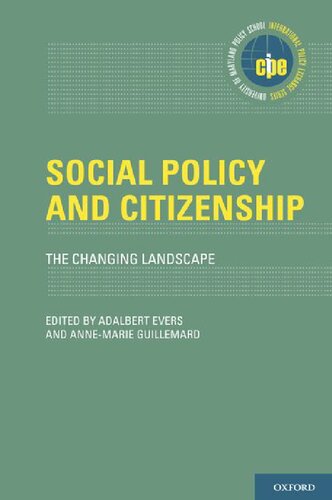

Most ebook files are in PDF format, so you can easily read them using various software such as Foxit Reader or directly on the Google Chrome browser.
Some ebook files are released by publishers in other formats such as .awz, .mobi, .epub, .fb2, etc. You may need to install specific software to read these formats on mobile/PC, such as Calibre.
Please read the tutorial at this link. https://ebooknice.com/page/post?id=faq
We offer FREE conversion to the popular formats you request; however, this may take some time. Therefore, right after payment, please email us, and we will try to provide the service as quickly as possible.
For some exceptional file formats or broken links (if any), please refrain from opening any disputes. Instead, email us first, and we will try to assist within a maximum of 6 hours.
EbookNice Team

Status:
Available5.0
35 reviews
ISBN-10 : 0199754047
ISBN-13 : 9780199754045
Author: Adalbert Evers, Anne-Marie Guillemard
This volume demonstrates the application of the constructivist approach to the analysis of foreign policy (i.e. states' actions in a world of states). Part I introduce constructivism for foreign policy studies. Part II presents five model case studies -- the Cold War, Francoism, the two Chinas, inter-American relations, and Islam in U.S. foreign policy. Part III reviews their results.
I Frameworks
1 Foreign Policy, International Politics, and Constructivism
FPA and IP, Agent and Structure
Constructivism into the Breach
Seven Questions
Before the Split: Classical Realism (Question 1, Table 1.1)
The Behavioral Side of the Split: Foreign Policy Analysis (Questions 2 and 5, Table 1.1)
The Systemic Side of the Split: International Politics (Questions 4, 5, and 6, Table 1.1)
Soft or Moderate, Structure- or Norm-Oriented Constructivism of Wendt, Katzenstein, and Others (Question 7, Table 1.1)
Notes
2 Foreign Policy Is What States Make of It: Social Construction and International Relations Theory
References
3 A Constructivist Primer
Seeing the Social World the Way a Rule-Oriented Constructivist Does
A Story of Visitors from Another Planet and Two Humans
Thinking Like a Constructivist and Learning Constructivist Categories
Translating Familiar Ways of Talking/Thinking into Constructivist Categories
Asking Questions Like a Constructivist
Note
References
4 Speaking of Policy
Commitments
Agreements
Gifts
Observers
Notes
References
II Constructivists at Work
5 Soviet “New Thinking” and the End of the Cold War: Five Explanations
About This Chapter
Trained to Ignore: The “New Thinking” and Western Scholarship Before the USSR's Collapse
Historiography of the Cold War, IR Neorealism, and Soviet “New Thinking”
“New Thinking” in Sovietology and in the, “Domestic Sources of Foreign Policy” Approach to FPA
After the USSR's Collapse: Neoliberal Institutionalism and Soft Constructivism and the “New Thinking”
Soviet “New Thinking” and Rule-Oriented Constructivism
From Common Sense to Rule-Oriented Constructivism
Soviet “New Thinking” from the “Horse's Mouth”
The Duality of the “New Thinking's” Sources
Rule-Orienied Constructivist Interpretation
Soviet Ideology
Gorbachev's Social Structure
The “Breakthrough”
Notes
References
6 Thus Spoke Franco: The Place of History in the Making of Foreign Policy
The Foreign Policy of Franco: A Crusader Without a Cause18
The Generation of Rule in Franco's Spain: Consequences for Foreign Policy
Conclusion
Appendix37
References
7 Failed Policy: Analyzing Inter-American Anticorruption Programs
The Constructivist Analytic Frame
Normative and Behavioral Perspectives of Corruption
Categorizing Political Cultures
Classifying Corrupt Behavior
Additional Factors Impacting Corrupt Behavior
Evaluating Governing Elite Interests
Appraising Elite Accountability
Assessing Material Resource Factors
The Need for Anticorruption Commitment Rules
Conclusion
Notes
References
8 Making Sense of the Conflict Between Mainland China and Taiwan
A Constructivist Perspective
Identity and Rule in the Cold War Era
Independence Movement and Diplomatic War in the 1980s
PRC–Taiwan Relations in the Post–Cold War Era
Changing Rules and Implications
“One China” Rule
Rule of “No Military Threat”
Reconstructing PRC–Taiwan Relations
Notes
References
9 Making Sense of the Conflict Between Mainland China and Taiwan
Discussing Self and Otherness
U.S. Policy Toward Islam—The Case of Bosnia
Intellectual Foundations of U.S. Foreign Policy Toward Islam
The United States and Islam
The United States in Bosnia, or the Case for Positive Engagement with Islam
Conclusion
Notes
References
III Reflections
10 Commonsense Constructivism and Foreign Policy: A Critique of Rule-Oriented Constructivism
Taking Issue with Mainstream Conservatives
The Revisionist Dilemma
The Limits Rationalism Sets
Transgressing the Limits Rationalism Sets by Taking Part
Transgressing the Limits Rationalism Sets by Post-Modernist Means
The Commonsense Alternative
References
11 Toward a Constructivist Theory of Foreign Policy
Constructivism and the Value of Identity
Alexander Wendt's Cultures of National Identity
The Limits of National Identity
Conclusion
Notes
References
social policy and social change pdf
social political landscape definition
sociopolitical landscape
social policy and social change jimenez
social policy in a changing world
Tags: Social Policy, Citizenship, The Changing Landscape, Adalbert Evers, Anne Marie Guillemard